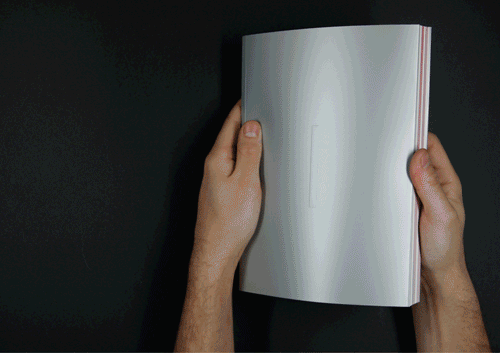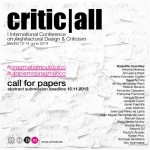Critic|all / #un-thology

Call for Papers
While Theory is produced, the History of Theory has to be constructed. Such an ambitious scope has been achieved by many different means but, among those, Anthology stands out as an effective instrument to present and connect apparently autonomous discourses in a way that actually describes a time-lapse situation. It performs a diagnosis.
The act of collecting –flowers, poems or architectural theory pieces [The etymological origin of the word ‘anthology’ comes from anthos (“flower, blossom”) + logos (“account”)] – is not innocent. Being the written equivalent of the museum, Anthologies curate knowledge, providing meaning for a collection of fragments. Not only Anthology is a genre that, as Sylvia Lavin once pointed, creates a genealogy for the present [Lavin, Sylvia. Theory into History, or The Will to Anthology”, Journal of the Society of Architectural Historians. Vol. 58, No. 3, Architectural History 1999/2000 (Sep., 1999), pp. 494-499], but also this kind of selected inventory of the past always claims a certain agenda for the future.
Paradoxically, the advent of what has been called ‘the end of theory’ in the late 90’s ran parallel to the publication of the two most significant anthologies that can be identified until now. The edited volume by Joan Ockman [Ockman, Joan. Architecture culture 1943-1968: a documentary anthology. New York, NY: Rizzoli, 1993] was born as seminar material and covers the period from 1943 to 1968. The one compiled by Michael Hays [Hays, K. Michael. Architecture Theory, Since 1968. Cambridge, Mass: The MIT Press, 1998] starts precisely at that point and, despite the openness implied in its title, concludes around 1993. Both anthologies largely differ in scope and purpose: while Ockman interest lays in the unveiling of modernism continuities under the more general concept of ‘culture’, Hays collection is a clear call to the critical function of ‘theory’ as a mode of resistance to, and mediation with, the sociopolitical context in which it is produced.
Certainly there are some other architectural text compilations that could be cited here, but only to load the scale towards the American commanded construction of the History of Theory, and in any case, none of them go hardly beyond the turn of the millennium. This would be the case of Kate Nesbit’s volume advocating for a ‘new’ agenda or the one edited by Neil Leach [Nesbitt, Kate. Theorizing a new agenda for architecture: an anthology of architectural theory 1965-1995. New York: Princenton Architectural Press, 1996] providing source texts form outside the discipline. The same could be stated of the two-volume collection curated by Francis Mallgrave [Mallgrave, Harry Francis. Architectural Theory. Vol. 1, An anthology from Vitruvius to 1870. Malden: Blackwell, 2006. Mallgrave, Harry Francis, and Christina Contandriopoulos. Architectural Theory. Volume 2. An anthology from 1871-2005. Malden: Blackwell, 2008] that unfolds in a holistic manner from Vitruvius to the first years of the 21st Century. The only exception to these western-anglo-saxon oriented compilations is The SAGE Handbook of Architectural Theory [Crysler, C. Greig, Stephen Cairns, and Hilde Heynen. The SAGE Handbook of Architectural Theory. London: SAGE, 2008], which addresses many contemporary debates from a wide variety of geographical and cultural points of view, resulting in a complex structure that nevertheless cannot be called an anthology, strictly speaking.
Amid this panorama, we put forward the following question: Is Anthology an obsolete instrument for current times or does it contain some kind of purpose? In front of the globalized flow of information, whether generated or consumed in endless forms of exchange and heterogeneous media, which parameters should we apply to handle relevance, content or completeness?
The construction of the next index of Theory will have to deal with the very idea of its usefulness, either as a classifying device, an editing instrument or the enhancement of an agenda. The impossibility of covering the whole spectrum of strands urges to confess partiality before taking the first step, loosing therefore the aspirations of encyclopaedic completeness that anthologies usually claim. It would be an impossible collection: never finished and, for this very reason, carrying out a critical stance towards the genre as an academic chimera.
Therefore, if we were to compile such an alternative Un-thology, which criteria should be implemented to make the choices of relevant texts? Should we dive into the endless ocean of officially indexed papers that grows exponentially in a monthly base? Are editorial statements still capable of identifying the new directions in architectural thought? How to deal with amateur writers in relation to institutionalized research conduits? What would be the rate of practicing architects authors vs other scholarship profiles?
You can download the full Call for Papers here.
The 3rd edition of the Critic|all Conference welcomes contributions that critically address these and other questions related to the proposed topic. We expect to receive two types of materials:
Con-texts
Short introductory essays that provide a context for a text dated between 1993 and the present and that is credited to be a significant spot in the recent history of architectural theory. In addition to the necessary review of what has already been said about the text, the paper should develop original arguments and clearly state the reasons why it should be included in a hypothetical Un-thology. We do not expect mere laudatory comments, but new insights on already published material.
The original text must not exceed 5.000 words, and should accompany the submittal. Justified excerptions are allowed. Papers should be 2.000 words length and must be written in English, unless the language of the source text is Spanish. Papers dealing with originals in any other language must provide a translation of it into English and should also be written in English.
No abstract is needed. Peer reviewing will be carried out in a single phase taking into consideration the full-paper submittal.
Full-paper Deadline: 1 February 2018
Length: 2.000 words max.
Research articles
Well constructed essays than engage with the problematization of the concept of Anthology, whether confronting two opposite discourses, analyzing the structure of previous compilations or discussing the procedures of architectural ideas dissemination. We expect interpretive work that draws new relations between things. The most basic form of this type of manuscript should present a thesis, back it up with arguments in the supporting body paragraphs and then bring the paper to a conclusion.
Papers should be 5.000 words length and must be written in English and will be preceded by a 300 words Abstract. Peer reviewing will be carried out in two phases.
Abstract Deadline: 8 November 2017
Full-paper Deadline: 1 February 2018
Length: 5.000 words max.
Schedule
November 8th, 2017 Deadline for abstracts
December 8th, 2017 Communication of abstract acceptance
February 1st, 2018 Deadline for early-bird registration
February 1st, 2018 Deadline for full papers
March 3rd, 2018 Announcement of invitations for oral presentations
April 10th, 2018 Deadline for standard registration
April 26th – 27th, 2018 Celebration of the conference
All info on Critic|all website
Related Posts
Questo sito usa Akismet per ridurre lo spam. Scopri come i tuoi dati vengono elaborati.








Lascia un commento